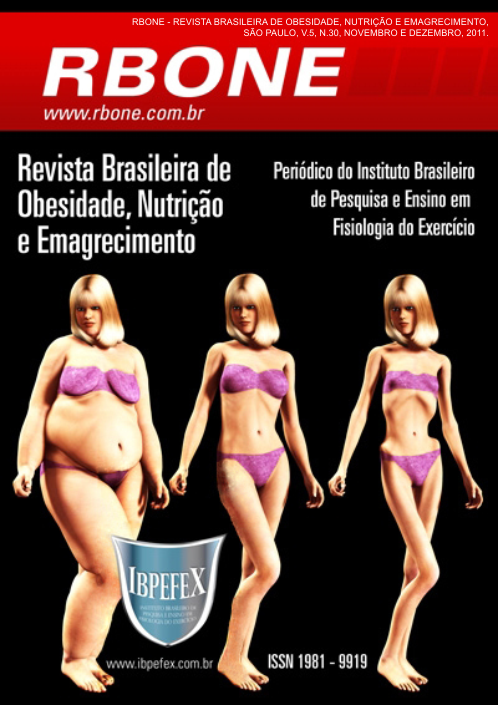Evaluation of whr in relation to reducing the risk of cardiovascular disease in individuals with abdominal obesity participants of treatment in a weight loss
Abstract
Introduction: Cardiovascular disease is considered worldwide the leading cause of death. The accumulation of fat in the abdomen has been described as the type of obesity that offers the greatest risk to the health of individuals (Pitanga and Lessa, 2005) to be a visceral fat mass, the most serious to increase risk of cardiovascular disease (Martins and Marine, 2003). Objective: Make sure the group of volunteers who joined the treatment (physical training, low-calorie diet and medication use orlistat) decreased more fully the risks of cardiovascular disease than the group that did not commit to the steps. The calculation for risk assessment was the WHR. Materials and Methods: The participants were eight people, two men and six women, three people followed the treatment in all its stages and five were not followed any of the three corresponding steps (exercise, diet or medication). The subjects were observed for 12 weeks. Results: The risk for cardiovascular disease decreased in five of eight volunteers. Discussion: There was one major difference from the waist circumference (WC) and hip circumference (HC) in the initial and final and initial and final of WHR in participantswho adhered completely to treatment than those who did not commit the same way with the stages of weight loss program. Conclusion: There has to be more effective to adhere to treatment altogether when an urgent need to reduce the risk of coronary heart disease.
References
-Boas, L. C. G.; Foss, M. C.; Foss-Freitas, M. C.; Torres, H. C.; Monteiro, L. Z.; Pace, A. E. Adesão à dieta e ao exercício físico das pessoas com diabetes mellitus. Texto Contexto Enferm. Vol. 20. Núm. 2. 2011. p. 272-279.
-Halpern, A.; Mancini, M.; Grinberg, M.; Segal, A. Diretrizes para Cardiologistas sobre Excesso de Peso e Doença Cardiovascular dos Departamentos de Aterosclerose, Cardiologia Clínica e FUNCOR da Sociedade Brasileira de Cardiologia. Arq. Bras. Cardiol. São Paulo. Vol. 78. 2002. p. 9-10.
-Martins, I. S.; Marinho, S. P. O potencial diagnóstico dos indicadores da obesidade centralizada. Rev. Saúde Pública. Vol. 37. Núm. 6. 2003. p. 760-767.
-Oliveira, M. A. M.; Fagundes, L. R. M.; Moreira, E. A. M.; Trindade, E. B. S. M.; Carvalho, T. Relação de indicadores antropométricos com fatores de risco para doença cardiovascular. Arq. Bras. Cardiol. Vol. 94. Núm. 4. 2010. p. 478-485.
-Pitanga, F. J. G.; Lessa, I. Indicadores antropométricos de obesidade como instrumento de triagem para risco coronariano elevado em adultos na cidade de Salvador-Bahia. Arq Bras Cardiol. Vol. 85. Núm. 1. 2005. p. 26-30.
-Rezende, F. A. C.; Rosado, L. E. F. P.; Ribeiro, R. C. L.; Vidigal, F.C.; Vasques, A. C. J.; Bonard, I. S.; Carvalho, C. R. Índice de massa corporal e circunferência abdominal: associação com fatores de risco cardiovascular. Arq. Bras. Cardiol. Vol. 87. Núm. 6. 2006. p. 728-734.
-Trombetta, I. C. Exercício físico e dieta hipocalórica para o paciente obeso: vantagens e desvantagens. Rev Bras Hipertens. vol. 1. n. 2. 2003. p. 130-133.
Authors who publish in this journal agree to the following terms:
- Authors retain the copyright and grant the journal the right of first publication, with work simultaneously licensed under the Creative Commons Attribution License BY-NC which allows the sharing of the work with acknowledgment of the authorship of the work and initial publication in this journal.
- Authors are authorized to enter into additional contracts separately for non-exclusive distribution of the version of the work published in this journal (eg, publishing in institutional repository or book chapter), with acknowledgment of authorship and initial publication in this journal.
- Authors are allowed and encouraged to post and distribute their work online (eg, in institutional repositories or on their personal page) at any point before or during the editorial process, as this can bring about productive change as well as increase impact and impact. citation of published work (See The Effect of Free Access).






